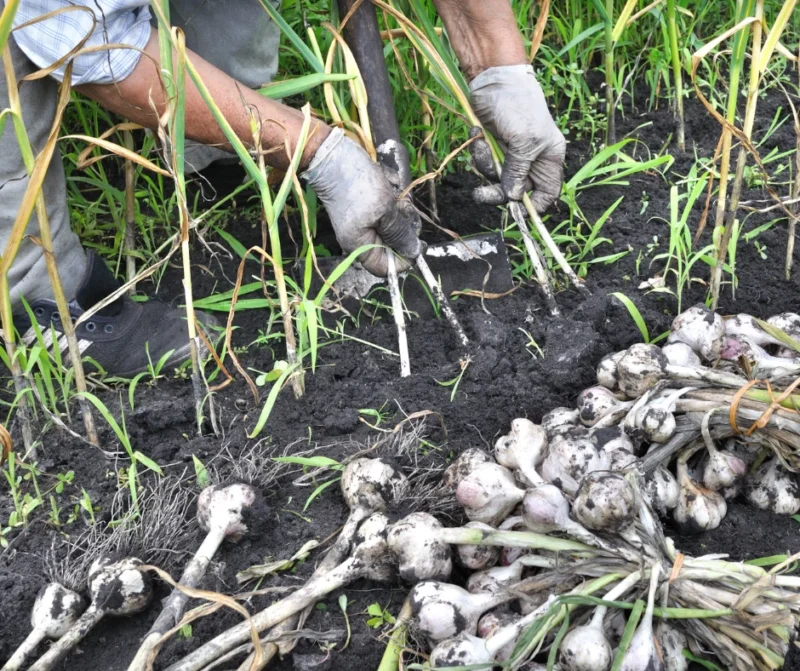Ever wanted to grow your own garlic and enjoy its robust flavor right from your garden? It’s easier than you think! Garlic is not only simple to plant and care for, but it’s also a low-maintenance crop that rewards you with fresh, flavorful cloves year-round. Imagine having a steady supply of homegrown garlic that you can use in all your favorite recipes—no trips to the store required!
But before you get started, it’s important to choose the right garlic variety for your climate and cooking needs. Whether you’re a beginner or an experienced gardener, this guide has everything you need to successfully plant, grow, and harvest garlic. Ready to dive in and learn how to grow your own garlic? Let’s get started!
Best Time to Plant Garlic
In most areas, fall, 4-6 weeks before the ground freezes, is generally the ideal time of year to plant garlic. And the ideal temperature for bulb formation is around 40-50°F / 4-10°C. Garlic should not be planted until after the autumnal equinox in late September, as a general rule.
Garlic, like onions and other plants in the Allium family, is day-length sensitive, maturing during the longest summer days. It will be one of the first plants to emerge in the garden the following spring thanks to fall planting, which offers it a heads up on the growing season.
Choose the Garlic Varieties
Understanding garlic and its soil needs is important for successful garlic growth, especially when planting garlic in the fall.
There are many different types of garlic, so you need to know which variety is suitable for your taste and the climate conditions in your area. True garlic falls into two main categories:
- Hardneck garlic has a stiff center stalk called a scape. It has a strong, spicy taste but doesn’t store well, lasting up to three months after harvest. Hardneck garlic usually has fewer than 12 large cloves that grow in a single layer around the stalk. It’s better for colder climates and often grows a flower stalk.
- Softneck garlic doesn’t have a hard stalk, making it flexible and good for braiding. It has a milder flavor and stores for six months or more. Softneck heads can have up to 40 small cloves in multiple layers and do better in warmer climates.
Is Store-Bought Garlic Plantable?
Supermarket garlic can work but we do not recommend this. Most grocery store garlic heads have been treated. Furthermore, the majority of commercial garlic is grown in different kinds of climates, so it could not grow well in your regional climate and might even bring pests or illnesses with it.
Prepare the Soil
Garlic thrives in a well-drained, airy soil that is rich in organic matter and adjusted to an ideal pH level. For optimal bulb formation and vigorous growth, remember to prepare the soil in early fall before the ground freezes.
How to Plant
- Before planting, separate the garlic heads into individual cloves. Keep as much of the papery skin on each clove intact as possible.
- Garlic thrives best in loose, well-drained, nutrient-rich soil. Avoid wet, clay soils to prevent bulb rot. After losing the soil to a depth of at least 8 inches, add some compost or granular organic fertilizer with a gradual release to the soil.
- Plant cloves 3 to 4 inches deep with the pointy ends facing upward. Space the cloves adequately to ensure good air circulation.
Watering and Mulching:
- Water gently to help the soil settle around the cloves.
- Cover the planting bed with a 4 to 6-inch layer of straw. Mulch helps suppress weed growth around the plants. Also, it will keep the soil warm enough for the cloves to develop roots before the ground freezes.
Growth Notes: Sometimes you’ll see some green shoots form in the fall; that’s fine and won’t harm plants. They’ll begin growing in earnest in spring.
Harvesting and Curing Garlic
Harvesting
On average, you’ll be waiting about 9 months from seed to harvest. Harvest time will likely be around the middle of July or as late as mid-August. When leaves begin to yellow and dry out, it is a sign of the time to harvest your garlic. At that time, bulbs have fully formed and are firm to the touch.
You can use a garden fork to gently lift the bulbs easily. After the garlic has been pulled up, shake off the loose dirt, but do not rinse or scrub the garlic that can damage your bulbs.
Harvest on dry days to prevent fungal infections.
Curing and Storage
- Hang or spread bulbs in a well-ventilated, dry area for 2-3 weeks.
- Store in a cool, dark, and dry place with good air circulation.
Tips for Planting Garlic
- Start with well-known, disease-resistant types like ‘Music’ (hardneck) or ‘Silverskin’ (softneck).
- Grow alongside onions, chives, or carrots to enhance growth and deter pests.
- Do not plant near legumes or beans to prevent disease transmission.




